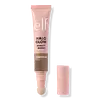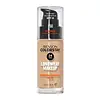e.l.f. cosmetics Halo Glow Contour Beauty Wand Versus Revlon Colorstay Makeup For Combination/Oily Skin SPF 15
What's inside
What's inside
 Key Ingredients
Key Ingredients

 Benefits
Benefits

 Concerns
Concerns

 Ingredients Side-by-side
Ingredients Side-by-side

Water
Skin ConditioningHydrogenated Didecene
Skin ConditioningIsododecane
EmollientGlycerin
HumectantPropylene Glycol
HumectantDimethicone
EmollientCetyl PEG/PPG-10/1 Dimethicone
EmulsifyingTrimethylsiloxysilicate
EmollientSqualane
EmollientMica
Cosmetic ColorantIsoamyl Laurate
EmollientPEG-10 Dimethicone
Skin ConditioningHydrogenated Styrene/Isoprene Copolymer
Sodium Chloride
MaskingPolyglyceryl-4 Isostearate
EmulsifyingDisteardimonium Hectorite
StabilisingSynthetic Sapphire
Caprylic/Capric Triglyceride
MaskingPropylene Carbonate
SolventTocopherol
AntioxidantHelianthus Annuus Seed Oil
EmollientCalendula Officinalis Flower Extract
MaskingPolymethylsilsesquioxane
Hydrolyzed Sodium Hyaluronate
Skin ConditioningSodium Hyaluronate
HumectantDisodium EDTA
Caprylyl Glycol
EmollientPhenoxyethanol
PreservativeEthylhexylglycerin
Skin ConditioningTriethoxycaprylylsilane
Aluminum Hydroxide
EmollientPentaerythrityl Tetra-Di-T-Butyl Hydroxyhydrocinnamate
AntioxidantCI 77891
Cosmetic ColorantIron Oxides
Water, Hydrogenated Didecene, Isododecane, Glycerin, Propylene Glycol, Dimethicone, Cetyl PEG/PPG-10/1 Dimethicone, Trimethylsiloxysilicate, Squalane, Mica, Isoamyl Laurate, PEG-10 Dimethicone, Hydrogenated Styrene/Isoprene Copolymer, Sodium Chloride, Polyglyceryl-4 Isostearate, Disteardimonium Hectorite, Synthetic Sapphire, Caprylic/Capric Triglyceride, Propylene Carbonate, Tocopherol, Helianthus Annuus Seed Oil, Calendula Officinalis Flower Extract, Polymethylsilsesquioxane, Hydrolyzed Sodium Hyaluronate, Sodium Hyaluronate, Disodium EDTA, Caprylyl Glycol, Phenoxyethanol, Ethylhexylglycerin, Triethoxycaprylylsilane, Aluminum Hydroxide, Pentaerythrityl Tetra-Di-T-Butyl Hydroxyhydrocinnamate, CI 77891, Iron Oxides
Titanium Dioxide
Cosmetic ColorantZinc Oxide
Cosmetic ColorantCyclopentasiloxane
EmollientWater
Skin ConditioningDimethicone
EmollientTrimethylsiloxysilicate
EmollientPEG-9 Polydimethylsiloxyethyl Dimethicone
EmulsifyingButylene Glycol
HumectantTribehenin
EmollientPhenyl Trimethicone
Skin ConditioningNylon-12
Cymbidium Grandiflorum Flower Extract
Skin ConditioningLactobacillus/Eriodictyon Californicum Ferment Extract
Skin ConditioningLilium Candidum Bulb Extract
Skin ConditioningMalva Sylvestris Extract
AstringentSodium Hyaluronate
HumectantTocopheryl Acetate
AntioxidantBisabolol
MaskingEthylhexyl Palmitate
EmollientTocopherol
AntioxidantAlcohol Denat.
AntimicrobialAlumina
AbrasiveDimethicone/PEG-10/15 Crosspolymer
Methicone
EmollientLaureth-7
EmulsifyingMagnesium Sulfate
Silica
AbrasivePolyglyceryl-3 Diisostearate
EmulsifyingEthylene Brassylate
MaskingTriethoxycaprylylsilane
Dimethicone/Silsesquioxane Copolymer
PEG-12 Glyceryl Dimyristate
Skin ConditioningSalicylic Acid
MaskingSilk Powder
Skin ConditioningSodium Citrate
BufferingDipropylene Glycol
HumectantSilica Dimethyl Silylate
EmollientSerica
HumectantTetrasodium EDTA
Hexylene Glycol
EmulsifyingCaprylyl Glycol
EmollientPhenoxyethanol
PreservativeEthylparaben
PreservativeMethylparaben
PreservativeMica
Cosmetic ColorantIron Oxides
CI 77891
Cosmetic ColorantTitanium Dioxide, Zinc Oxide, Cyclopentasiloxane, Water, Dimethicone, Trimethylsiloxysilicate, PEG-9 Polydimethylsiloxyethyl Dimethicone, Butylene Glycol, Tribehenin, Phenyl Trimethicone, Nylon-12, Cymbidium Grandiflorum Flower Extract, Lactobacillus/Eriodictyon Californicum Ferment Extract, Lilium Candidum Bulb Extract, Malva Sylvestris Extract, Sodium Hyaluronate, Tocopheryl Acetate, Bisabolol, Ethylhexyl Palmitate, Tocopherol, Alcohol Denat., Alumina, Dimethicone/PEG-10/15 Crosspolymer, Methicone, Laureth-7, Magnesium Sulfate, Silica, Polyglyceryl-3 Diisostearate, Ethylene Brassylate, Triethoxycaprylylsilane, Dimethicone/Silsesquioxane Copolymer, PEG-12 Glyceryl Dimyristate, Salicylic Acid, Silk Powder, Sodium Citrate, Dipropylene Glycol, Silica Dimethyl Silylate, Serica, Tetrasodium EDTA, Hexylene Glycol, Caprylyl Glycol, Phenoxyethanol, Ethylparaben, Methylparaben, Mica, Iron Oxides, CI 77891
 Reviews
Reviews

Ingredients Explained
These ingredients are found in both products.
Ingredients higher up in an ingredient list are typically present in a larger amount.
Caprylyl Glycol is a humectant and emollient, meaning it attracts and preserves moisture.
It is a common ingredient in many products, especially those designed to hydrate skin. The primary benefits are retaining moisture, skin softening, and promoting a healthy skin barrier.
Though Caprylyl Glycol is an alcohol derived from fatty acids, it is not the kind that can dry out skin.
This ingredient is also used as a preservative to extend the life of products. It has slight antimicrobial properties.
Learn more about Caprylyl GlycolCi 77891 is a white pigment from Titanium dioxide. It is naturally found in minerals such as rutile and ilmenite.
It's main function is to add a white color to cosmetics. It can also be mixed with other colors to create different shades.
Ci 77891 is commonly found in sunscreens due to its ability to block UV rays.
Learn more about CI 77891Dimethicone is a type of synthetic silicone created from natural materials such as quartz.
What it does:
Dimethicone comes in different viscosities:
Depending on the viscosity, dimethicone has different properties.
Ingredients lists don't always show which type is used, so we recommend reaching out to the brand if you have questions about the viscosity.
This ingredient is unlikely to cause irritation because it does not get absorbed into skin. However, people with silicone allergies should be careful about using this ingredient.
Note: Dimethicone may contribute to pilling. This is because it is not oil or water soluble, so pilling may occur when layered with products. When mixed with heavy oils in a formula, the outcome is also quite greasy.
Learn more about DimethiconeMica is a naturally occurring mineral used to add shimmer and color in cosmetics. It can also help improve the texture of a product or give it an opaque, white/silver color.
Serecite is the name for very fine but ragged grains of mica.
This ingredient is often coated with metal oxides like titanium dioxide. Trace amounts of heavy metals may be found in mica, but these metals are not harmful in our personal products.
Mica has been used since prehistoric times throughout the world. Ancient Egyptian, Indian, Greek, Roman, Aztec, and Chinese civilizations have used mica.
Learn more about MicaPhenoxyethanol is a preservative that has germicide, antimicrobial, and aromatic properties. Studies show that phenoxyethanol can prevent microbial growth. By itself, it has a scent that is similar to that of a rose.
It's often used in formulations along with Caprylyl Glycol to preserve the shelf life of products.
Sodium Hyaluronate is hyaluronic acid's salt form. It is commonly derived from the sodium salt of hyaluronic acid.
Like hyaluronic acid, it is great at holding water and acts as a humectant. This makes it a great skin hydrating ingredient.
Sodium Hyaluronate is naturally occurring in our bodies and is mostly found in eye fluid and joints.
These are some other common types of Hyaluronic Acid:
Learn more about Sodium HyaluronateTocopherol (also known as Vitamin E) is a common antioxidant used to help protect the skin from free-radicals and strengthen the skin barrier. It's also fat soluble - this means our skin is great at absorbing it.
Vitamin E also helps keep your natural skin lipids healthy. Your lipid skin barrier naturally consists of lipids, ceramides, and fatty acids. Vitamin E offers extra protection for your skin’s lipid barrier, keeping your skin healthy and nourished.
Another benefit is a bit of UV protection. Vitamin E helps reduce the damage caused by UVB rays. (It should not replace your sunscreen). Combining it with Vitamin C can decrease sunburned cells and hyperpigmentation after UV exposure.
You might have noticed Vitamin E + C often paired together. This is because it is great at stabilizing Vitamin C. Using the two together helps increase the effectiveness of both ingredients.
There are often claims that Vitamin E can reduce/prevent scarring, but these claims haven't been confirmed by scientific research.
Learn more about TocopherolTriethoxycaprylylsilane is a silicone used to bind and stabilize ingredients.
As an emulsifier, it helps prevent ingredients from separating. This can help elongate the shelf life of products.
Triethoxycaprylylsilane is often used to coat mineral sunscreens ingredients to help give a better feel. It also helps reduce oxidative stress in sunscreens.
Learn more about TriethoxycaprylylsilaneThis silicone is an emollient. Emollients create a thin film on the skin to prevent moisture from escaping.
It is not soluble in water and helps increase water-resistance in products.
According to a manufacturer, it can blend seamlessly with silicone oils, such as Cyclopentasiloxane.
Learn more about TrimethylsiloxysilicateWater. It's the most common cosmetic ingredient of all. You'll usually see it at the top of ingredient lists, meaning that it makes up the largest part of the product.
So why is it so popular? Water most often acts as a solvent - this means that it helps dissolve other ingredients into the formulation.
You'll also recognize water as that liquid we all need to stay alive. If you see this, drink a glass of water. Stay hydrated!
Learn more about WaterThis ingredient is a combination of red, black, and yellow iron oxide pigments. This combination of colors is usually found in foundation, because it results in a "skin" color.